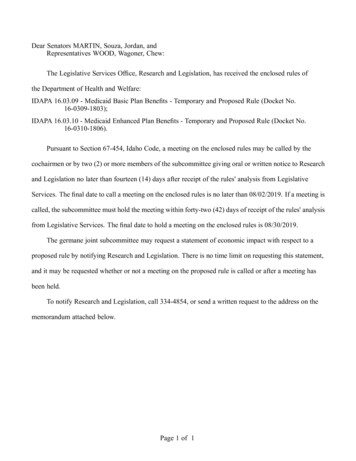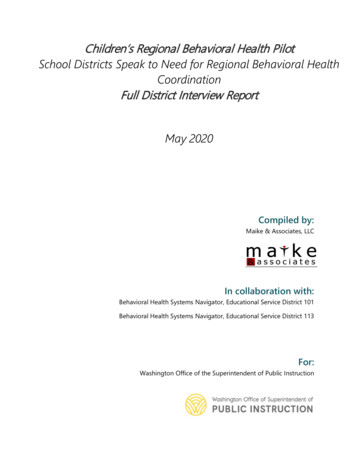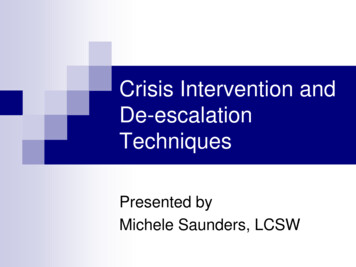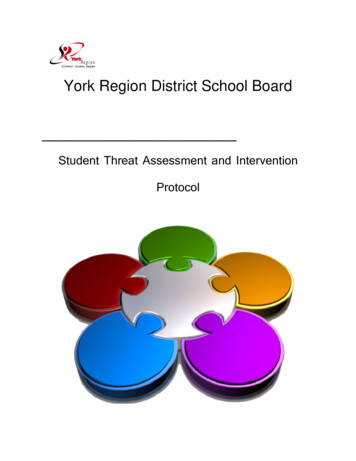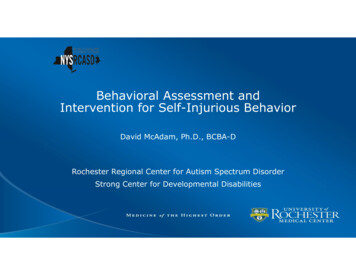
Transcription
Behavioral Assessment andIntervention for Self-Injurious BehaviorDavid McAdam, Ph.D., BCBA-DRochester Regional Center for Autism Spectrum DisorderStrong Center for Developmental Disabilities
2
RRCASD Webinar SeriesGet Started on Your Path to EmploymentKaitlyn Richardson, M.P.P.Wednesday, March 14, 20183:00-4:00 p.m.Register at www.scdd.urmc.edu/rrcasd
David B. McAdam, PhD, BCBA-DUniversity of Rochester School of MedicineDepartment of PediatricsStrong Center for Developmental DisabilitiesWarner School of Education and HumanDevelopmentFebruary 2018Rochester Regional Center for Autism SpectrumDisorder
Learning Objectives Increase understanding of Understanding of challenging behavior and SIB Risks associated with SIB Why persons with developmental disabilities engage inSIB The behavioral assessment of SIB Interventions for SIB that can be implemented byparents and service providers Understanding of situations which suggest that parentsand professional without specific training requireadditional help
Emerson ( 2005 ) defined challengingbehavior as:“ culturally abnormal behaviour of suchintensity, frequency or duration that thephysical safety of the person or others isplaced in serious jeopardy, or behaviourwhich is likely to seriously limit or denyaccess to the use of ordinary communityfacilities ”What is missing from this definition?
Types of Challenging Behavior Displayed byPersons with ASD Self-injurious behavior (SIB) Aggression Stereotypic Behavior Tantrums (non-compliance paired with negative vocalizations,and aggression) Property Destruction Feeding Problems (only eating a small number of foods) Pica Rumination
Definitions of Self-injurious BehaviorSelf-injurious behavior (SIB), displayed by individualswith autism and intellectual disabilities, involves theoccurrence of behavior that results in physical injury toone's own body (Kennedy Krieger Institute).SIB is defined as behaviors that result in physical injuryto an individual’s own body (Center for AutismResearch; The Children’s Hospital of Philadelphia) .
Common forms of SIB Head Banging Punching oneself Hitting oneself Hand Arm Biting Picking skin or sores Pica (swallowing non-edible items or objects) Excessive skill rubbing or scratching Rumination
Characteristics of persons with intellectualdisabilities who display SIB: Gender: Males 57% Female 43% Level of Mental Retardation: 71% with severe or profound mentalretardation Negative relationship between I.Q. andprobability of displaying SIB.Kahng et al. (2002)
Secondary Diagnoses Visual impairments (14%) Autism (10%) Hearing impairments (6%)Kahng et al. (2002)
Topographies of Self-injury Head hitting Hair pulling Biting self Eye poking Hand mouthing Pinching self Body hitting Kicking Self (e.g., knee to head) Pica Rumination
Potential Detrimental Consequences ofSIB Interferes with learning (i.e., reduced rate of learning) Increases monetary cost of serving a person in his or herlifetime. Frequently results in placement in more restrictive settings Often result in referral to specialist (for example, a BCBA-Dor licensed psychologist with specific training in selfinjurious behavior)
Causes/Theories of SIBWhy Do Individuals with AutismEngage in SIB?
Biological Setting Events Pain due to: Otitis Media Headaches Gastroesophageal RefluxDisease or other GI problems Menstrual Pain Sleep Deprivation Mood Allergies (skin scratching)
Environmental Setting Events Noise Crowded situations Certain people or activities
Medical CausesSome individuals with ASD are hypothesizedto engage in SIB as a way to relieve pain. Bystimulating pain in a controlled way (throughengaging in SIB), a person may seeks to maskanother pain, such as an ear infectiontoothache, headache, or constipation.
Genetic PredispositionResearch studies have shown that someindividuals’ genes may make them more likely toengage in SIB. Genetic syndromes include: Lesch-Nyhan Prader-Willi Smith-Magenis Fragile X de Lange
Operant CausesSocial Positive ReinforcementSocial Negative ReinforcementNon-social ReinforcementLet’s look at each of these in some detail
Social Positive Reinforcement(positive reinforcement) Person with Autism engage in SIB in order to getattention from other people or access to a highpreference item or activity Attention may be from parent, teacher, peer, oronly during specific situations (for example, twopeople talk to each other but not to the person) To get a specific preferred item (for example,cookies, stuff animal, video game such as MarioCart)
Example of Positive ReinforcementJohn often hits himself in the head withhis hand. Each time he hits himself he isreprimanded by his mother. John’sfrequency of SIB increases over time.
Social Negative Reinforcement (negativereinforcement) SIB allows a person to escape from anactivity (for example, math, brushingyour teeth) SIB allows a person to avoid a situationthat they find aversive
Example of Negative ReinforcementWhen asked to complete activities ofdaily living, such a brushing her teeth,Susan often bites herself on the hand.Susan’s teachers typically stop promptingher to complete the task. Susan’sfrequency of biting her hand increasesover time.
Automatic Reinforcement SIB is maintained by non-social factors SIB is not mediated by the actions of other people SIB should be as likelihood to occur when anindividual is alone as in the presence of other people
Example of AutomaticReinforcementJohn is alone in the front room of hisgroup home. John is seated in a chairand occasionally hits himself in thehead.
Arousal TheoryIndividuals may engage in SIB to increase their arousal level or tocounteract feeling over aroused. SIBs may be an attempt to releasetension or relieve anxietyNote: Arousal theory has been very difficult to demonstrateconvincingly and current level of supporting evidence is not great.
Functional Communication and SIB Many individuals with ASD have some form of communicationdifficulty. SIB is seen most frequently in individuals with ASD who lackfunctional communication skills to express their wants and needs. Theinability to communicate one’s wants and needs sets the occasion forSIB.
Discussion of the Assessment ofSIB
How Often is SIB Socially Maintained versusAutomatically Maintained? About 60% of SIB is socially maintained Approximately about 40% of SIB is non-sociallymaintained
Why do we want to collect data? To be sure that the behavior in question is reallya problem To be sure that the change in behavior reallyhappened To make sure that all team members agree onthe desired behavior change To serve as a source for functional assessment
Functional (Behavioral) Assessment IDEA 1997 mandated that a functionalbehavioral assessment is part of any writtenbehavior plan Overarching goal of functional assessment isto determine why the behavior occurs Takes into account medical, genetic, andbiological factors as well as environment Today’s best practices in assessment andintervention of problem behavior includes anFBA
Why should we care about thefunction of a problem behavior? When you know “WHY” a person isdisplaying SIB, you can better help aperson decrease the behavior We usually try and find out why a personengages in SIB before we develop anintervention
Three Types of Functional Assessments Questionnaires: Questions About Behavior Function (QABF) Motivational Assessment Scale (MAS) FAST (Functional Analysis Screening Tool) Direct observation: ABC Analysis Scatter Plot Experimental or Functional Analysis
Questionnaires (MAS; QABF, FAST)Advantages: Easy to use and do not require much formal trainingDisadvantages: Often do not provide a clear answer. Might result in thedevelopment of a treatment that is less likely to be effective
Type of Questions Contained on Indirect Measures Engages in behavior to get attention (QABF) Engages in behavior when peer has something that he/she wants (QABF) Does the behavior seem to indicate to you that he/she is not feeling well? (QABF) Does the behavior seem to occur in response to your talking to other persons in the room? (MAS) Does the behavior occur whenever you stop attending to the person (MAS) Does the behavior occur when you take away a favorite toy, food, or activity (MAS)MAS 6 point scale QABF 5 point scale
Direct ObservationDirect observation in daily environment– Focuses on observable antecedentsand consequences of behavior; canalso get information about time of day,duration, and frequency of problembehavior– Can be done by outside observers fora specific interval of time– Data can also be collected by parents,teachers, or staff throughout the day
Conducting a Functional AnalysisDone when still don’t know the function to theproblem behaviorInvolves directly manipulating the antecedents andconsequences for behaviorSometimes called an Experimental analysis or anAnalog Functional AnalysisNeeds to be done by someone with experience indoing them (a BCBA or Behavior analyst)
Typical Functional Analysis Conditions Negative Reinforcement (Demands) Positive Reinforcement (Tangible items or SocialAttention) Automatic Reinforcement (Alone or Ignore) Control or Toy Play
65Toy PlayNumber per MinuteTangible4AloneSocial At t ent ionDemand3210123456789 10 11 12 13 14 15 16 17 18 19 20 21 22 23 24 25 26 27 28 29 30SessionSIB
Functional Analysis32.5Aggression Per Minute2Toy PlaySocial Attention1.5TangibleDem and10.5012345678910 11 12 13 14 15 16 17 18 19 20Session
Interventions for SIBBased on Behavioral Function
Developing a HypothesisOnce a functional assessment has been conducted, a hypothesisis developed regarding the function or purpose the behaviorservesUse this hypothesis to develop an interventionCan intervene at many levels:–Modify the setting event/establishing operation–Modify the antecedent–Change or add reinforcement to affect the consequence ofbehavior–Provide the same of similar source of sensory (automatic)reinforcement
Antecedent-based InterventionsAntecedent Environmental Manipulation-Alteringaspects of an individual’s surrounding that mayserve as a discriminative stimulus (cue or signalfor SIB) for SIB, that will in turn may modify theSIB in some way.
Interventions – AntecedentsModify antecedents for behavior byremoving or modifying the things that“set off” behavior–Eliminate specific tasks–Go from easy to difficult tasks–Embed tasks–Change the prompts (the way youprovide directives or instructions)–Change the way that materials arepresented–Break down activity into discrete stepsand (using task analysis)
Reinforcement-Based Interventions Contingent Reinforcement Non-contingent reinforcement Differential reinforcement
Differential Reinforcement Procedures DRO-a reinforcement procedure in which an individual or groupreceives a reinforce for completely refraining from a specificbehavior for a specified period of time regardless of other behaviorsdemonstrated DRA-Reinforcing a more appropriate from of a behavior than the onethe that the person is currently engaged in (functionalcommunication training, engagement in a specific activity) DRL-delivering reinforcement when h the number of responses in aspecified period of time is less than or equal to a prescribed limit.This maintains a behavior at a predetermined rate, lower than at itsbaseline or naturally occurring frequency
Functional Communication TrainingTeaching a verbal or non-verbal communicationskill to gain access to desired items/activities or toavoid non-preferred activities in a pro-socialmanner, so that it replaces SIB that had been usedfor the same purposeOnly applied to socially-maintained challenging behavior
3FCT ExtinctionBaselineFR 1FCT ExtinctionFCT ExtinctionBaselineFR 1TherapistgeneralizationSIBResponse per on35373941434547495153555759
Extinction (Planned Ignoring) Withholding the reinforcer that is maintainingSIB(e.g., attention from other people) May not be treatment of choice with severe SIB Very difficult to implement consistently acrossall people and settings Possibility of extinction burst Always a good idea to minimize attention forbehavior you do not want
Extinction8070Response Per 021232425
Punishment-based InterventionsA consequence that decreases the probabilityof the subsequent occurrence of the behaviorit follows (Arzin & Holz, 1966)
Contingent Aversive Stimuli That Have BeenUsed to Treat Self-Injury Facial or Visual Screen 30-second Basket-hold Response Cost Overcorrection Time-out
Time-outTime-out is the withdrawal of theopportunity to earn positive reinforcementor the loss of access to positive reinforcersfor a specified period of time contingent onthe occurrence of a targeted behavior
Response CostA punishment-based procedure in which thelost of a specific amount of reinforcementoccurs, contingent on the display of atargeted behavior (Cooper, Heron, andHeward, 1987)
Unexpected Side effects of Punishment Avoidance of problem situations andproblem people Does not teach replacement behavior Is a poor model for the individual Shouldn’t be a first choice for interventionand only done combined with reinforcementprocedure Self-restraint – treatment can be difficult
Interventions for Automatically MaintainedChallenging BehaviorsWhy do interventions for socially maintainedchallenging behavior look very different thaninterventions for automatically maintainedchallenging behavior?
McCord, B. E., Grosser, J. W., Iwata, B.A., & Powers, L. A. (2005)Response Blocking58
59
Favell, McGimsey, & Schell, 1982Environmental Enrichment/Non-ContingentReinforcement/Competing items60
61
Hagopian et al. 2011Differential Reinforcement62
63
64
65
Medication-Based Treatment Some Data that support the use of medications for SIB, particularly SIBmaintained by biological or internal variables (i.e., automaticreinforcement). For example, Risperdal, Abilify. People generally follow least-restrictive alternative model
Thanks for Attending!!Questions, Discussion, andProblem SolvingContact information:David Mcadam@urmc.rochester.edu67
Feb 21, 2018 · Feeding Problems (only eating a small number of foods) Pica Rumination. Definitions of Self-injurious Behavior Self-injurious behavior (SIB), displayed by individuals with autism





